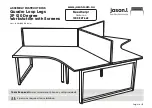
- Internal Details -
The format of the data which is burned into the Eproms is in blocks of 1
KByte each. The first byte of the audio data is normally replaced by one flag
byte. This sets the operating settings for the following 1023 audio data bytes.
Bits 0 to 2 set the sample rate, while bits 3 to 5 set the output filter cutoff
point. The last two bits flag the ends of samples.
bits 2 1 0
sample rate frequency cutoff
1
1
1
35,156.25 Hz
15.00 KHz
1
1
0
23,437.50
10.00 KHz
1
0
1
17,578.125
7.50 KHz
1
0
0
11,718.75
5.00 KHz
0
1
1
8,789.00
3.75 KHz
0
1
0
7,031.00
3.00 KHz
0
0
1
4,687.00
2.00 KHz
0
0
0
Delay
7
OFF
bits 5 4 3 filter frequencyfrequency cutoff
1
1
1
1.5 MHz
15.00 KHz
1
1
0
1.0 MHz
10.00 KHz
1
0
1
750.0 Khz
7.50 KHz
1
0
0
500.0 KHz
5.00 KHz
0
1
1
375.0 KHz
3.75 KHz
0
1
0
300.0 KHz
3.00 KHz
0
0
1
200.0 KHz
2.00 KHz
0
0
0
OFF
8
OFF
bit6:
0
no effect
1
end of all sampled data after this 1 KByte is played.
bit7:
0
no effect
1
stop after this 1 KByte is played.
G
ILDERFLUKE
& C
O
.
¥
205 S. F
LOWER
¥
B
URBANK
, C
A
91502-2102
¥
818/840-9484
¥
800/776-5972
¥
F
AX
818/840-9485
67 of 72
7
If the sample frequency is set to delay, then the next two bytes following the flag byte
are used to set how long the delay will be (MSB first). Each count is equivalent to one 1
KByte block of data played when played at a 15 KHz bandwidth (this is equal to
1024/35,156.25 of a second). The normal flag byte for the remaining 1021 bytes of
data follows the two delay bytes. All four of these flag bytes take the place of the nor-
mal flag bytes which would be found in these positions.
8
This condition doesn't effect the frame rate, but just shuts down the output filter.






































